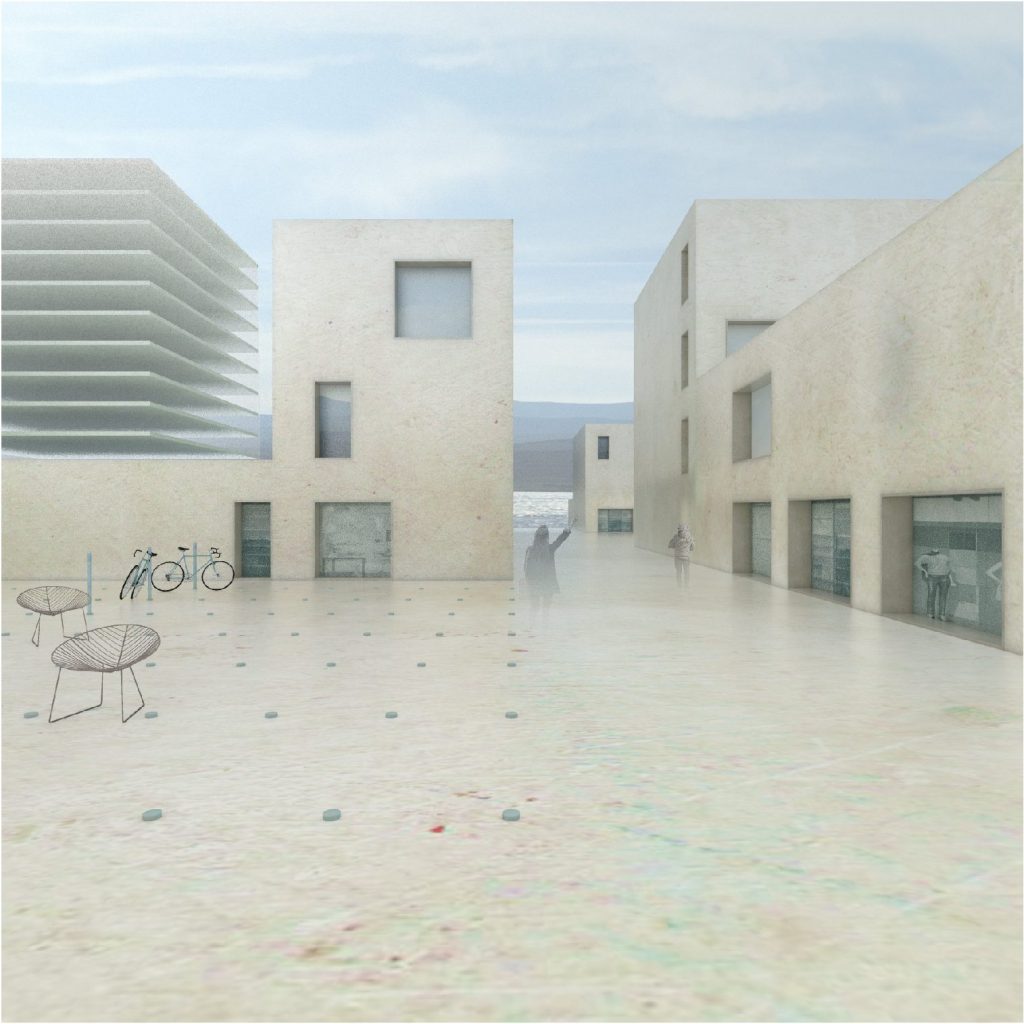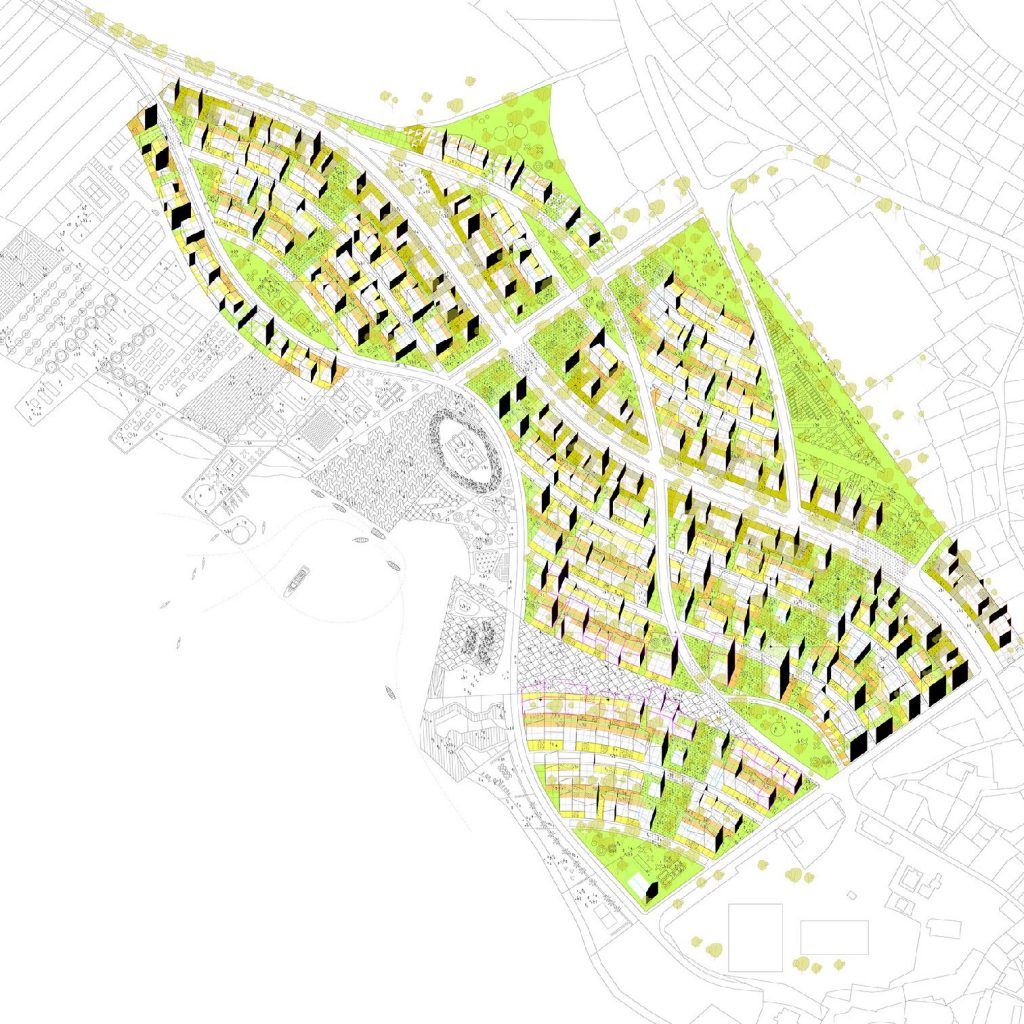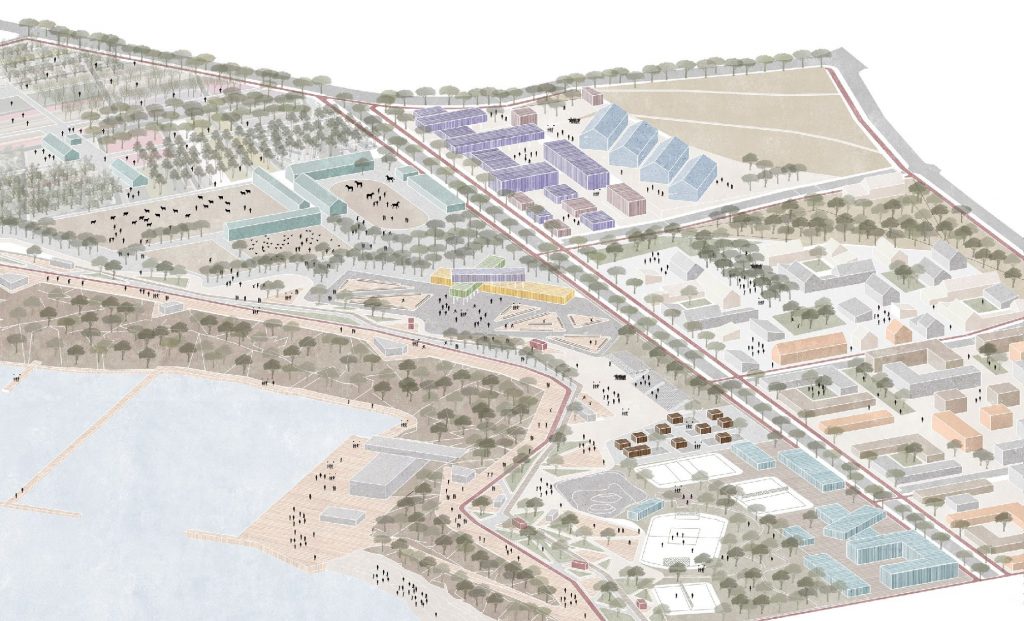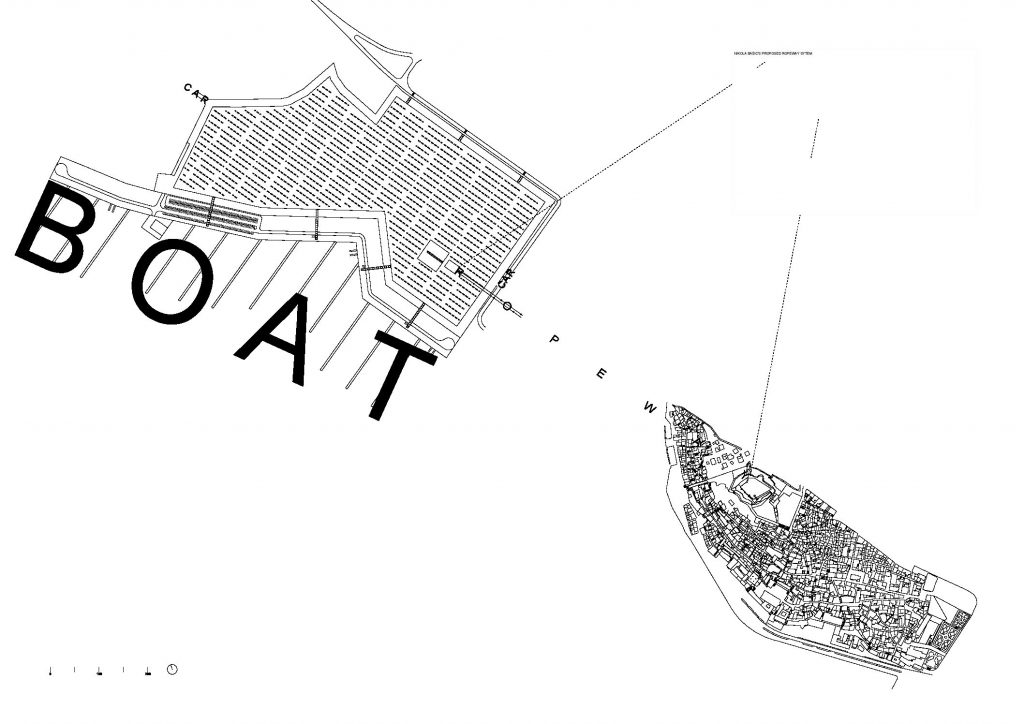Europan 14
Europan 14: Produktivni grad
Nakon dva ciklusa istraživanja teme prilagodljivog grada
Europan se sada fokusira na produktivne gradove
Koliko je uistinu mješovit grad mješovitih funkcija?
Stanovanje je i dalje osnovna namjena u većini projekata koji se planiraju ili grade u postindustrijskim gradovima. Urbanisti u program uključuju uredske prostore i javne sadržaje, ali najviše su skloni poticati sadržaje kao što su barovi, trgovine i restorani zato što svaku novu četvrt planiraju kao “istinski živu gradsku četvrt”. Kad se osvrnemo na planerske trendove urbane obnove, primjećujemo kako se proizvodnu namjenu sustavno isključuje.
Danas je u mnogim europskim gradovima prisutan prostorni i socijalni raskorak između uvjeta rada i životnih uvjeta. Gradovi visokoobrazovanim stručnjacima nude brojne poslovne prilike, dok niskoobrazovana radna snaga ima manje šanse da pronađe posao u gradu. Taj raskorak je uzrok mnogih gospodarskih, transportnih i društvenih problema.
Naravno, rješenje nije u gradnji čeličana u centru grada; no danas svjedočimo povratku raznih oblika proizvodnje manjeg mjerila u urbano okruženje. Sve veći broj reciklažnih pogona smješta se unutar gradova. Mogli bismo sustavno rezervirati dio prostora za male i srednje proizvodne pogone u programima razvoja. Trebali bismo izbjegavati da vodoinstalater koji živi u gradu i popravlja instalacije u gradu ne može imati prostor za skladište unutar tog grada. Trebamo ohrabrivati smještanje proizvodne funkcije unutar grada kako bi ona postala sastavni dio gradskog tkiva, vidljiva, povezana sa svakodnevnim životom i uvažena. Kakve su mogućnosti da se takav grad ostvari?
Pitanja koja se postavljaju, a koja predstavljaju izazove 14. ciklusa Europana:
Kako uključiti neke proizvodne aktivnosti u grad- kao što je proizvodnja hrane, energije, jednostavne usluge, nova industrijska proizvodnja – kako bi se intenzivirali odnosi unutar stanovništva?
Kako živjeti u proizvodnim zonama i kako uključiti proizvodnju u stambene zone?
Kako uključiti sve faze proizvodnog ciklusa obzirom na distribuciju, otpad i potrošnju?
Izazov Europana 14 je kako stvoriti novu blizinu povezivanjem stanovanja i produktivnosti.
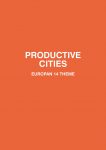
Šibenik
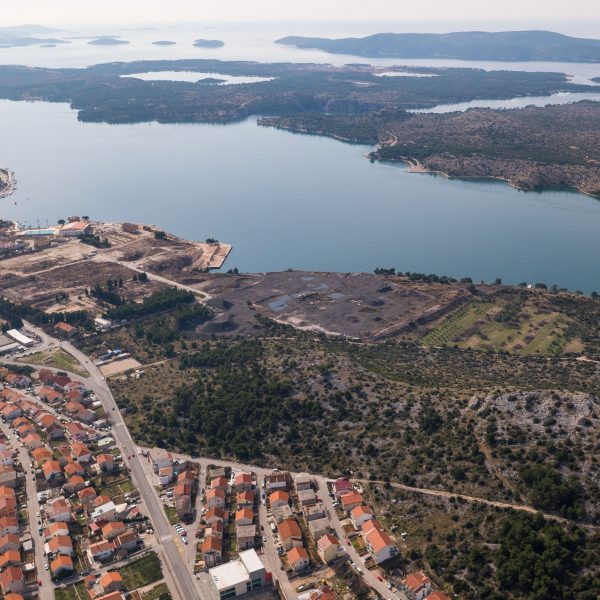
Mjesto: http://www.europan-europe.eu/en/session/europan-14/site/sibenik-hr
Naseljenost: 46.332 stanovnika
Strateško područje obuhvata: 17,3 ha
Područje provedbe projekta: 2,5 ha
Lokaciju predložio: Grad Šibenik
Post-natječajna faza: Urban study, master-plan, construction
Šibenik
Mjesto: http://www.europan-europe.eu/en/session/europan-14/site/sibenik-hr
Naseljenost: 46.332 stanovnika
Strateško područje obuhvata: 17,3 ha
Područje provedbe projekta: 2,5 ha
Lokaciju predložio: Grad Šibenik
Post-natječajna faza: Urban studija, master-plan, izgradnja
Entry Conditions
Entrants
Europan 14 is open to any team consisting of one architect in partnership or not with one or more professionals of the same or other disciplines of the urban-architectural field (architects, urban planners, landscapers, engineers, artists…)
Every team member, whatever his/her profession, must be under the age of 40 years old on the closing date for submission of entries.
Composition of the Teams
There is no limit to the number of participants per team. Multidisciplinarity is strongly recommended with regards to the sites issues.
A registered team can modify its composition on the European website until the closing date for submissions. No further change shall be accepted after this date.
Each team member (associate and collaborator) shall be registered as such on the European website before the closing date for submissions.
One team can submit a project on different sites and one person can be part of different teams provided that the projects are submitted in different countries.
Associates
Associates are considered to be authors of the project and are credited as such in all national and European publications and exhibitions. They are young professionals with a university degree recognised by the Directive 2005/36/EC of the European Parliament and of the Council of 7 September 2005 on the recognition of professional qualifications, in any of the relevant disciplines and regardless of nationality. The compulsory requirement is to hold such a degree.
Membership in a European professional body is optional, except for associates without a European degree.
Contributors
Teams may include additional members, called contributors. Contributors may be qualified or not but none of them shall be considered as an author of the project. Just like the associates, the contributors must be under the age of 40 years old on the closing date for submission of entries.
Team Representative
Each team names one Team Representative among the associates: the Team Representative is the sole contact with the national and European secretariats during the whole competition. Furthermore, every communication shall be done with one sole email address, which shall remain the same during the whole competition.
The Team Representative must be an architect or must have the architect status under the laws of a European country. In specific cases and when mentioned on the site definition (see Synthetic Site File), the Team Representative can be an architecture, urban or landscape professional (architect, landscaper, urban planner, architect-engineer). In this case the team shall necessarily include at least one architect among the associates.
Non-Eligibility
No competition organizer is eligible to take part in the competition – neither are their employees and members of their families.
Are considered as organizers: the members of the Europan structures; the representatives of the sites proposed in the current session; the members of technical committees; the observers; and the jury members.
Registration
Registration is done on the European website – www.europan-europe.eu – and implies the acceptance of the competition rules.
In compliance with French Act #78-17 of Jan. 6th, 1978, on Information Technology, Data Files and Civil Liberties the protection of personal data communicated during registration is guaranteed.
Europan 14 Website
The European website for the fourteenth session of the competition is available online from the opening date of the competition, at the following url – www.europan-europe.eu
It includes: the complete European rules for the Europan 14 competition; the session topic; the Synthetic and Complete Site Files grouped geographically or by themes; the juries compositions; and an organisational chart of all the Europan structures.
The website also offers the possibility to register to the competition and submit the complete proposals.
Team Registration
Registration to the competition is done through the European website (Registration section) and implies the payment of a €150 fee. There shall be no refund of the registration fee.
The fee includes access to one Complete Site File and the printing of the panels –necessary for the evaluation– on a rigid support by the national secretariats.
Payment is automatically confirmed on the website. The team can then access a personal area and the digital entry area, and download the Complete Site File for the selected site.
An additional Complete Site File costs €50 per site.
Information Available to Teams
Synthetic Site Files – Free Download
The Synthetic Site Files present a summary vision of the site. They are available for free on the site presentation pages of the European website and help the teams select their project site(s).
This document is in English and sometimes also in the site language.
The Synthetic Site Files provide for each site:
Good-quality iconographic documents:
- 1 map of the city or conurbation identifying the location of the study site and giving the graphic scale;
- 1 aerial picture of the study site in its context identifying the location of the study site in red and the project site in yellow;
- 1 oblique aerial picture (semi-aerial) of the study site;
- 1 oblique aerial picture (semi-aerial) of the project site;
- 1 map of the area identifying the study site and the graphic scale;
- 1 map of the area identifying the project site and the graphic scale;
- at least 3 to 6 ground-level pictures showing the site’s characteristic elements (topography, natural features, existing architecture);
Written information:
- the site category;
- the profile of the team representative: architect or professional of the urban design;
- names of the town and place; population of the town and conurbation; surface area of the study and project sites; representative of the site; site owner(s); expected follow-up after the competition;
- the developer’s and the city’s specific objectives; strategic issues of the site; relation to the session topic: “Productive Cities”.
Briefs – Free Download
The Brief is a 10-to-15-page illustrated document, the aim of which is to provide a better understanding of the main elements of the context through the existing elements as well as through the site’s mutation issues and its environment. It is available for free on the site presentation pages of the European website and includes the following elements:
- A summary of the main elements of the site;
- The site specificities – site representative; others actors involved; function of the team representative; expected skills among the teams; post competition phase; operational mission;
- A detailed analysis of the regional and urban context, putting in perspective the transformations of the city and the region and including all the elements on this scale that may have a current or future influence on the site –mobility networks, ecological elements, urban structure, landscape, etc.– within the general framework of productive cities;
- A detailed analysis of the study site putting in perspective the transformation of the site (the site and its environment) and illustrating how the session topic is taken into account.
The following information is also provided:
– Role of the study site in the city policy, with details on the goals of the planning imagined by the municipality;
– Programmatic framework: planned transportation networks; public and private spaces to build and/or upgrade, with assumptions about planned functions and/or dimensions; goals for public spaces and infrastructures; and detailed explanations of the choices of the developers for each aspect of the programmes. - A detailed analysis of the project site putting in perspective the site transformation and the way to make it productive.
The programmatic framework is also detailed, with: the spaces to build and/or regenerate, with functions and dimensions; the precise goals for public spaces and infrastructures; detailed explanations of the developers’ intentions on the parts of the programmes to be included. - The main elements linked to the Europan 14 topic and their implication on uses and flexibility of spaces (built and public), natural elements and implementation processes of the mutation;
- A description of the sociocultural context of the site, the city and the region and its evolution to help participants better understand the local urban lifestyles and the citizens’ rhythms;
- A description of the economical context of the site, the city and the region and its evolution to help participants better understand the potential productive spaces to create.
This document is in English and sometimes also in the site language.
Complete Site Files
The Complete Site Files include detailed visual documents on the city, the site, the context as well as drawings, pictures and any graphic document required for the design process.
These Files are available on the site presentation pages of the European website after registration on the site and logging in to the website.
They include pictures, diagrams and graphics of the following scales:
a. Territorial Scale – Conurbation
- 1 aerial picture of the city;
- 1 map on regional (urban geography) or urban scale (conurbation) with an appropriate graphic scale showing the major features structuring the area (buildings, networks, natural features).
b. Urban Scale – Study Site
- 1 aerial picture of the study site;
- at least 1 semi-aerial picture of the study site;
- at least 5 ground-level pictures showing the characteristic features of the study site: topography, natural features, existing architecture, etc.;
- plans of the study site with an appropriate scale;
- characteristic features: infrastructure, existing and future plans, etc.
c. Local Scale – Project Site
- at least 3 semi-aerial pictures of the project site;
- at least 10 ground-level pictures showing the characteristic features of the project site: 5 topography, natural features, existing architecture, etc.;
- map(s) of the project site with an appropriate scale, showing:
– the project site’s location within the study site;
– the project site’s plot divisions, constructions, natural elements, etc.; - topographical map of the project site with an appropriate scale and, if necessary, characteristic features (buildings and natural features to be retained or not, etc.)
FAQ
Questions on the sites
A meeting is organised with the teams and the municipalities and/or developers on each site to give a detailed picture of the issues related to the site. The national structure of the site then publishes a report in English in a maximum of two weeks after the meeting. This report is available online on the site presentation pages of the European website.
In addition to this an FAQ section is open on each site webpage on the European website for a limited period of time (see calendar). Only the registered teams can ask questions on sites.
Questions on the rules
An FAQ section on rules is open on the European website for a limited period of time.
Submission of Entries
Digital Submission
Digital submission is compulsory. It includes the 3 A1 panels, documents proving the eligibility of the team members and documents for the communication of the project.
The complete submissions shall be submitted by midnight (Paris time) on June 30th, 2017, on the European website (Entry section).
Failure to comply with the hereunder-mentioned requirements on panel presentation may result in the disqualification of the team.
The number of entries per site is available on the European website on the European map of the sites (column on the right).
Anonymity and Compulsory Content
The site name and the project title must be displayed on every A1 panel.
A specific code is automatically attributed to each project upon upload. The teams do not know this code, through which the jury members take note of the project. The teams’ identities are revealed via an automatic link between the code and the team on the online projects database.
Language
The panels shall be either written in English or bilingual (English + the site language).
Items to Submit
Submissions include documents divided as follows:
- 3 vertical A1 project panels;
- Documents proving the eligibility of the team members;
- Documents for communication (3 images + a short text)
A1 Panels
Content – The 3 panels must:
- explain the urban ideas developed in the project with regards to the site issues and the themes of the session;
- present the project as a whole, highlighting the architecture of the project, and particularly the relationship between the new developments and the site’s existing context, including three-dimensional representations of the project
All graphic and descriptive documents must have a graphic scale.
Technical spectifications:
- PDF format;
- Vertical A1 (L 594 mm x H 841 mm) ;
- Maximum 20 Mb;
- One box (L 60 mm x H 40 mm) is left blank in the upper left corner for the automatic insertion of the code; the name of the city must be placed next to it;
- Panels numbered from 1 to 3 in the upper right corner;
- The team is free to decide on the positioning of the proposal title.
Documents to prove the eligibility of the team members
Documents for the disclosure of names and verification of the validity of the proposals shall be uploaded as PDF’s on the European website.
Personal information include:
- For the team: the Team Form and Declaration of Author – and Partnership and of Acceptance of the competition rules available online on the team’s personal area; to be filled out and signed;
- For each team member:
– A copy of an ID document with a picture, providing evidence that they are under the age of 40 at the closing date for submission of entries (see calendar.)
– A copy of their European degree as an architectural, urban or landscape professional (architect, landscaper, urban planner…) or proof of such a status under the law of a European country.
No other document than the ones above-listed is necessary.
Attention: The personal documents must be uploaded individually for each team member before the submission deadline. Only team members that correctly registered and submitted their eligibility documents separately shall be considered within the team final composition. The upload of one sole document with all the required information (copies of the ID’s and degrees) will not be accepted.
Documents for the project communication
Each project must be summered up as follows:
- One short text of maximum 2,500 signs (spaces included, to be typed in during submission);
- 3 separate PDF images that symbolize the project (max. 1Mb per image).
Control of the Submissions
Each team can check the upload of their projects on their online personal area. They can also –if needed– modify these documents until the deadline for submissions.
A period of 7 days is left open after the deadline for submissions (see Calendar) for the European secretariat to control the upload of each submission sent before the expiry of the deadline, as well as to correct the potential problems that might have appeared during the upload of the documents.
Results and Prizes
Results
The list of the Europan 14 winning teams (Winners, Runners-up, Special Mentions) is available online from December 1st, 2017, on the European website.
Winners
Winners receive a reward of the equivalent of €12,000 (all taxes included) in the currency of the site’s country (at the exchange rate on the date of the announcement of the results). The organizers undertake to abide by the decisions of the national juries and to pay the reward within 90 days of the announcement of the results.
Runners-up
Runners-up receive a reward of the equivalent of €6,000 (all taxes included) in the currency of site’s country (at the exchange rate on the date of the announcement of the results). The organizers undertake to abide by the decisions of the national juries and to pay the reward within 90 days of the announcement of the results.
Special Mentions
A Special Mention can be awarded to a project considered innovative although not completely adapted to the site. The authors of such proposals do not receive a reward.
Communication of the Competition
Events
- At the national scale of the organizing and associate countries
Promotion is organized about the competition launch.
After the first jury round, an exhibition or online publication of all the submissions on one site can be organised, provided that it respects the teams’ anonymity and it is correctly communicated beforehand. This communication shall be specified in the site brief.
The results announcement is accompanied with results ceremonies and presentations and/or workshops creating a first contact between the winning teams and the site representatives. - At the European scale
A European event called Inter-Sessions Forum is the link between a finishing session and the beginning of the new one. This forum gathers the winning teams and site representatives of the finishing session and the site representatives of the new one around the results and first implementation steps of the projects awarded during the last session.
A €500 compensation is granted by the National Secretaries to each winning team (winners and runner-up) participating to the Forum to cover the journey and accommodation expenses.
Publications
The competition results can be the opportunity for publications in every organizing or associate country.
The European secretariat publishes a catalogue with the European results along with expert analyses. This catalogue is available either for free consultation or for sale on the European website.
Websites
Websites are open by the national structures to promote the current session, future events and archives (previous sessions, team portraits, etc.) At the European level, the European website allows participants to find information on all the sites, to register to the competition, to submit their projects and to know all the results of the current session on the European level.
Rights and Obligations
Ownership
All material submitted to the organizers becomes their property, including reproduction rights. The intellectual property rights remain the exclusive property of their author(s).
Exhibition and Publication Rights
Moratorium on Publication
Teams may not publish drawings submitted to the competition or disclose their names by using their project for any communication before the official announcement of the results. Any such publication may result in the disqualification of the team.
Publications
The organisers reserve the right to publish all the projects submitted to them. Projects are exhibited or published under the names of their authors.
Disputes
The Council of the Europan European Association, which is empowered to arbitrate, shall hear any dispute.
List of Europan 14 Competitions
The Contact section of the European website shows the detailed national competition conditions country by country (number of sites and prizes, conditions of construction rights, etc.) as well as the details of the national and European structures, with the names of the people working for them.
The Jury section of the European website lists the members of the national juries.
Kalendar natječaja Europan 14
14-15. listopada 2016: Međuciklusni forum (lokacije)
NATJEČAJ
Raspis natječaja
Ponedjeljak,. 13. veljače 2017.
Rok za postavljanje pitanja
Petak, 13. svibnja 2017., 23:59 (GMT +1): Rok za postavljanje pitanja
Petak, 2. lipnja 2017., 23:59 (GMT +1): Rok za objavu odgovora
Rok za registraciju
Ponedjeljak, 30. lipnja 2017., 23:59 (GMT +1): Rok za registraciju
Predaja radova
Petak, 9. srpnja 2017. 23:59 (GMT +1): Rok za predaju natječajnih radova
Ponedjeljak, 10.srpnja 2017.: Objava privremenog popisa primljenih radova
Petak, 14. srpnja 2017,: Rok za provjeru primljenih radova i objava konačnog popisa primljenih radova
Žiriranje
srpanj-studeni 2017.: Rad ocjenjivačkog suda
Listopad 2017.: – Forum gradova i žirija
Rezultati
Petak, 1. prosinca 2017.: Objava rezultata
Studeni 2018.: Međuciklusni forum (rezultati)
Ocjenjivački sud Europan 14
Iva Letilović dipl.ing.arh., AB Forum, Zadar, Hrvatska
Jens Brandt dipl.ing.arh., Danska
Zoran Zidarić dipl.ing.arh., Zagreb, Hrvatska
Ingrid Gojević dipl.ing.arh., Zagreb, Hrvatska
Prof. Tihomir Jukić Prof. dipl.ing.arh., Zagreb, Hrvatska
Vasa J. Perović dipl.ing.arh., Bevk Perović arhitekti, Slovenija
Ana Šverko dr. sc. dipl.ing.arh., Split, Hrvatska
Zamjenski članovi
Borka Bobovec dr. sc. dipl.ing.arh., Zagreb, Hrvatska
Lulzim Kabashi dipl.ing.arh., Ivanisin & Kabashi Arhitekti, Zagreb, Hrvatska
PRVA NAGRADA
"PK370" - PLACE
Autor(i): Ewa Odyjas i Agnieszka Morga, arhitektice, Ruda Slaska, Poljska
Suradnici:
DRUGA NAGRADA
"GM490" - GIVE ME 5!
Autor(i): : Ivan Samaniego Piquero, José Miguel Sánchez Moreno, Eugenia Concha Gimenez-Coral, arhitekti, Madrid, Španjolska
Suradnici:
POSEBNO PRIZNANJE
"KG354" - PRODUCTOURISM
Autor(i): Roy Nash i Luca Astorri, arhitekti, Milano, Italija
Suradnici: Matilde Villa, Valeriia Aksenfeld, Georgievska Elena, Giulia Tosarello, studenti arhitekture
POSEBNO PRIZNANJE
"VA221" - MANGAN CITY OVERDRIVE
Autor(i): Ante Sušić, mag.ing.arh., Zagreb, Hrvatska
Suradnici:
